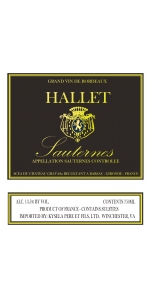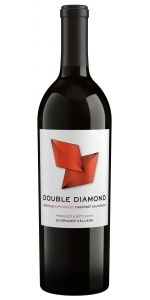Gravas Sauternes 2022 (half-bottle)
6 bottles with free shipping for: $162.00
12 bottles with free shipping for: $264.00
| BUY MORE! SAVE MORE! | ||||||||||||||||||||
|
Gravas Sauternes is a blend of 100% Sémillon.
The wine shows a lovely pale golden color with deep golden highlights. Round and well-balanced offering complex aromas of candied fruits backed up by a hint of exotic fruit (mango, guava) and white flowers. On the palate, it is ample and fleshy, leading into a silky and long finish.
The wine pairs well with white meats, scallops, exotic and spicy dishes, foie Gras, Roquefort blue cheese, chocolate desserts.
The Gravas Estate
Chateau Gravas was founded in 1789 and has been in the Bernard family for five generations. It is currently owned by Michel and Florence Bernard.
The name "Gravas" comes from "graves", a gravelly soil that perfectly suits the production of Sauternes wines.
The estate is superbly located in Barsac between Chateau Coutet, Chateau Climens and Chateau Doisy-Daene. The total production is 2,000 cases/year.
The Gravas Vineyard
There are 8 hectares (19.8 acres) of vineyard for the production of Sauternes. The soil is a mix of clay, sand and limestone. The 60 year-old vines are harvested by hand: the grapes are picked in successive passes. The wine is aged in both French and American oak barrels. There are 5 villages in Sauternes: Preignac, Barsac, Fargues, Beaumes and Sauternes.
Gravas Sauternes is a blend of 100% Sémillon.
The wine shows a lovely pale golden color with deep golden highlights. Round and well-balanced offering complex aromas of candied fruits backed up by a hint of exotic fruit (mango, guava) and white flowers. On the palate, it is ample and fleshy, leading into a silky and long finish.
The wine pairs well with white meats, scallops, exotic and spicy dishes, foie Gras, Roquefort blue cheese, chocolate desserts.
Hallet Sauternes is made from 100% Sémillon.
With delicate aromas of honey, citrus, crystallized fruit and acacia, it makes a good match not only for desserts, but also for foie gras, roasted meats and blue cheeses.
It makes a delicious aperitif when served chilled.
Double Diamond by Schrader Oakville Cabernet Sauvignon is made from 100 percent Cabernet Sauvignon.
Barrels: 54% new French oak, 46% second-use Schrader Darnajou French Oak
The 2022 Cabernet Sauvignon offers concentration, lively acidity, and refined tannins that have become the hallmark of the 2022 vintage. The nose holds notes of black raspberry, toasted cedar, juicy plum, and pennyroyal mint—a Napa Valley Cabernet Sauvignon signature. The palate is mouthwatering with intricately woven layers of blackberry compote, dark chocolate shavings, oolong tea, and flint. The dynamic flavors carry across the mid-palate in vivid harmony into a long, floral finish. This wine is ready to drink upon release but will cellar well for years to come.
Double Diamond is sourced exclusively from a complement of prime vineyard estates. Sourced from the same famed vineyards as its beloved inspiration Schrader Cellars in Napa Valley’s world-renowned Oakville AVA, including our To Kalon Vineyard.
Grand Veneur Chateauneuf du Pape Rouge Le Miocene is made from 70% Grenache, 20% Syrah, 10% Mourvèdre .
An intense dark-ruby color. The nose develop aromas of ripe black fruit (such as blackberry), cherry and spice box. The palate reveals the presence of tannins, in high quantity and elegant. The finish is long and luxurious. This is the Châteauneuf du Pape expression, displaying all the characteristics of the terroir.
Soil type: Plots are located northern part of Châteauneuf du Pape and the vines are grown under organic process.The soil is marked by the violence wrought by the Rhone river. It consists of a layer of marine molasses of the Miocene period covered by alpine alluvium. The presence of a great number of rounded stones known as "galets" in the earth is evidence of the time when the Rhone, then a torrent, tore fragments of rock from the Alps and deposited them on the plain. The GRAND VENEUR cuvee will express year after year a great power and aromatic complexity.
Winemaking & ageing: Harvest is sorted by hand, destemmed and crushed. Fermentation temperature is controlled at 30°C. Vatting period of 18 to 20 days. Matured in vats and oak casks.
Review:
"The 2022 Châteauneuf du Pape Le Miocene checks in as 70% Grenache, 20% Syrah, and the rest Mourvèdre, all destemmed, that was raised mostly in tank, with the Syrah and Mourvèdre in oak. It has a beautiful nose of ripe red and black fruits that give way to more licorice, black olive, peppery garrigue, and spices. Medium to full-bodied on the palate, it's balanced and has ripe, building tannins and a great finish. It's going to evolve gracefully for 10-12+ years."
- Jeb Dunnuck (Importer Highlight: Fran Kysela ; July 2024), 93 pts
Hallet Sauternes is made from 100% Sémillon.
With delicate aromas of honey, citrus, crystallized fruit and acacia, it makes a good match not only for desserts, but also for foie gras, roasted meats and blue cheeses.
It makes a delicious aperitif when served chilled.
Landes Cuvee Tradition Lussac Saint Emilion (half-bottle)is made from 80% Merlot, 15% Cabernet Sauvignon and 5% Cabernet Franc
Color: deep ruby intense color.
Aroma: racy and aromatic nose with aromas of ripe red fruit.
Taste: this wine is silky, round and smooth first taste, with aromas of raspberries, and blackcurrant, powerful and complex finish.
- back
“1752” is the name of the Damilano Barolo Cannubi Riserva, in honor of the year in which the historic bottle was first marked “Cannubi”. It still exists today perfectly conserved by the Manzone family in Bra, close to Barolo. The bottle is clearly marked as being of “1752” vintage, indicating that Cannubi historically precedes Barolo.
About the Vineyard:
The Cannubi Cru is in found within one of the 6 core zones which comprise a UNESCO heritage site in Italy. A mixture of Tortonian and Helvetian calcareous marl gives the grapes intense aromas of cherry, plum and tobacco, rose and violet in sequence. Its low potassium and high calcium/magnesium content offer the wine a fine and polished touch. The vineyard is located at about 270 m. a.s.l. and has a south-east sun exposure. Barolo Riserva Cannubi 1752 It is a small plot of about 2 hectares of Nebbiolo vines, currently between 30 and 50 years of age.
Tasting Notes:
Garnet ruby red in color, the bouquet is intense and balanced, with notes of violet, red fruit, cherry and plum, spices, liquorice, cocoa, leather and tobacco. Dry, robust, full-bodied, very persistent, rich and velvety
Food Pairing:
This wine is excellent with typical piedmontes pasta (tajarin, ravioli); perfect with red meat, braised and roast meat, game and absolutely ideal with all types of cheeses.
Review:
The purity of this wine is pretty phenomenal with blackberries, strawberries, fresh flowers and licorice. Hints of tar. It’s full-bodied, yet composed and compact with ultra fine tannins and a long, flavorful finish. Very structured. Try after 2024.
-James Suckling 97 Points
Filippino Elio Barolo Riserva is made from 100 percent Nebbiolo.
This 100% Nebbiolo offers a fruity, floral and spicy bouquet of red roses, raspberry, cinnamon and cocoa. It is generous, enveloping and elegant in the mouth, yet intense and full-bodied.
The grapes undergo a soft crushing and destemming leading to a clear must. This must ferments in steel tanks at a controlled temperature of 26°C and macerates for 20-25 days. After racking, the wine undergoes a lengthy maturation in oak barrels, which is continued with a lengthy bottle-ageing. Bottle-ageing confers the wine’s final character, at which time the wine is sent to market and from there to consumer tables.

-220x165.jpg)
-150x300.jpg)







